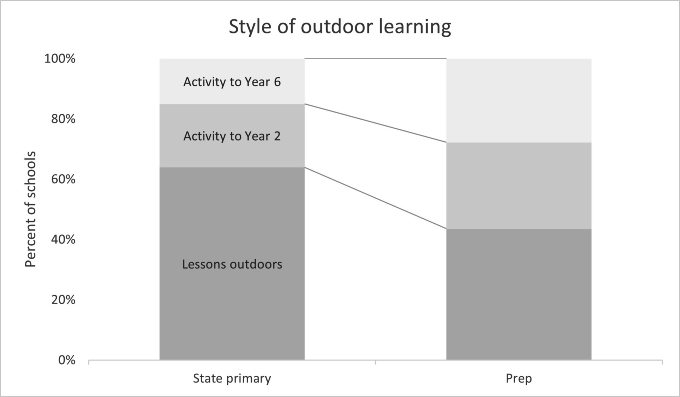In 2023 it would be rare to find a prep or primary school that didn’t offer outdoor learning in some shape or form. It’s everywhere.
Now, compare that to how I started out the 2017 version of this article;
‘More and more prep and primary schools are offering outdoor learning to their Nursery and Reception pupils. Some are also offering continuous outdoor learning programmes to older pupils.’
It wouldn’t be an exaggeration to suggest that outdoor learning has been one of the main drivers of curriculum development over that time. Maybe it is a reaction to the pervasive smartphone and a perceived antidote to social media induced hyperactivity and anxiety.
But outdoor learning means different things to different people. And therefore, a key school differentiator.
For some schools, it is teaching some subjects outside. At others, it is some kind of woodland or beach activity. For some wealthier prep schools, outdoor learning has been an opportunity to build lavish woodland facilities, tree houses, high and low rope courses, zip-wires, pizza ovens and fire pits.
In fact, outdoor learning has become such as popular element of the curriculum that there is a charity, the Council for Learning Outside the Classroom (CLOtC), that helps educators plan outdoor activities. It awards accreditations, and its definition of outdoor learning embraces outdoor learning, school trips, residentials and visiting speakers.
Recognising that one day, I might have to merge this article with the one on educational trips, residentials and guest speakers, I’ll keep the focus on this one to outdoor learning.
What outdoor learning do primary and prep schools offer?
I’m going to focus on three main types using data from the 2023 Schoolsmith sample of 3,000 prep and primary schools.

The first point to make is that very few do not engage in outdoor learning. And they tend to be private, faith-centric schools.
Taking curriculum lessons outdoors
The most popular style of outdoor learning is ‘lessons outdoors’, taking the curriculum out of the confines of the four walls and into fresh air. 64% of primary schools and 44% of prep schools mean ‘lessons outdoors’ when they refer to outdoor learning.
Here, at the most basic level is pond-dipping, observing nature and even baking-soda rockets in the playground. But it doesn’t have to be just science. There’s painting and sketching, re-enacting historical battles, building willow shelters, acting scenes from plays. Every subject has some element that can be usefully and imaginatively taught outside.
What’s important is how often, and how systematically. A school that is truly differentiating itself with ‘learning outdoors’ will have outdoor sessions for all or most subjects on a regular basis for all year groups. It takes a lot of curriculum planning. And luck with the weather.
‘Forest School’ activities
The second most popular style of outdoor learning is the ‘Forest School’ activity for the youngest children, Nursery to Year 2. It may have a name such as Woodland Wanderers or even something like Muddy Wellies. And yes, the activities might also include horticulture, pond dipping, woodland walks, observing flora and fauna, even husbandry. But the point is that there is some degree of exertion involved, sessions are continuous rather than one-off, and participation is not weather dependent.
This is outdoor learning for 20% of state primary schools and 29% of prep schools. The ‘muddy wellies’, ‘muddy knees’, and ‘climbing trees’ idea used to be a differentiating rallying cry for prep schools. State primary schools are catching up.
Forest School is a term misapplied throughout outdoor learning provision, with different meanings for different schools. Sometimes it refers to a lesson taken outdoors, or a lesson referring to time spent in woodland, or even the facility that the lessons take place in. The essence of Forest School is that it is a method of teaching. It is child-led learning, not teacher-instructed, and facilitated by ‘qualified level 3 Forest School practitioners’. Children are encouraged to take managed risks in an outdoor (Forest) setting. And sessions take place regularly throughout the year with children developing an appreciation of the outdoors.
Adventurous activities
The third style is an extension of the second; outdoor adventurous learning for all pupils in the school, including the older ones. It will often incorporate hikes, camping and trips and is often billed as challenge, adventure, resilience or even leadership activities.
The inspiration is the type of activity we see at secondary school; Duke of Edinburgh Award, John Muir Award, CCF, Adventure Service Challenge and the like. There are schemes at the junior level, such as Mini-Dukes, but they tend to be bespoke to the school and driven by an enthusiastic teacher. Look for activities that build on the nature observation in infant years such as bush craft and camp craft. Also, expeditions that demand more of the pupil than an afternoon canoeing, fun as that might be.
15% of state primary schools and 28% of prep schools offer this level of outdoor learning. The outdoors is very much part of the school DNA. Outdoor learning is not only integrated into the curriculum but is continuous through the year and through the year groups. The schools may also participate in related environmental schemes such as Eco Schools.
These schools offer the most trips, and residentials start at a very early age. There may also be significant facilities on school premises, especially at prep schools.
Why has outdoor learning become so popular?
Take your pick; outdoor learning is often described as a reaction or an antidote to many societal ills. From pandemic lockdowns, smart phones, social media, inactivity and obesity, to increasing awareness of mental health.
But it’s not a new idea. Some schools have had outdoor education built into their curriculum for many years. The Waldorf Steiner schools are a good example as are the Round Square organisation of schools. Forest School has been active since the 1950s in Scandinavia and in Denmark, specialist Forest Schools account for 10% of all pre-schools. The concept was introduced to the UK in the 1990s.
Even before COVID lockdowns, the uptick in popularity of outdoor education reflected fears that urban and sedentary lifestyles are affecting children’s health. The rise of childhood obesity and ADHD was well documented. Influential studies that made headlines before the pandemic included;
- Children spend twice as much time playing on screens than playing outside (2016, Unilever)
- 74% of 5-12 year-old children spend less time outside than prison inmates (2016, Unilever)
- Less than 10% of children have access to outdoor education (2016, Environment Agency)
- Less than 10% of children regularly play in wild spaces compared to over 50% a generation ago (2012, National Trust)
The benefits of outdoor learning
The list of benefits of outdoor learning is long and often anecdotal. But the most validated reasons are that outdoor education;
- Boosts self-confidence, self-esteem and self-reliance.
- Promotes team building, cooperation, camaraderie and personal responsibility within a group.
- Increases awareness of the Environment and our impact on it.
- Improves problem solving skills.
- Encourages risk taking and independent learning.
- Is beneficial to health; physical, mental, sensory and sleep.
Will outdoor learning in primary schools increase further?
I think so. All the underlying drivers of demand are still strong, and some maybe getting stronger. In addition, there is an increasing trend to teach practical skills, life skills, resilience and ‘character’. Though as a word of caution, schools that major on outside learning have only achieved limited presence in UK schooling. Schools such as Montessori Schools, and Steiner Schools. Maybe their time has come?
The supply side is a limiting factor. Not so much the competence of suppliers or designated staff, but the time available. The 32.5 hour school week affords just over five hours actual teaching time per day, after lunchtimes and breaks.
Many schools have a ‘subject co-ordinator’ for outdoor learning, as with all subjects. But when it comes to curriculum planning, there are two emerging trends. At advanced ‘lessons outdoors’ schools planning for outdoor learning is shifting to the class or subject teacher. At adventurous learning schools, the remit is moving into the PE/sports department.
It remains to be seen whether more schools will pursue the more adventurous learning path or the more ‘lessons outdoors’ path.
Should outdoor learning affect your school choice?
Fun as they are, a trip to a zip-wire centre is probably not going to influence your choice of school. But if the school embraces a continuous outdoor learning programme, then that school is demonstrating a commitment to varied styles of learning and all the benefits that an outdoor education will bring. If you consider traditional pedagogy to be a priority, and that time spent away from maths, English and science as downtime, then outdoor learning won’t weigh heavily in your priorities. If you’re looking for a balanced and rounded education, then outdoor learning might be in your decision mix.
